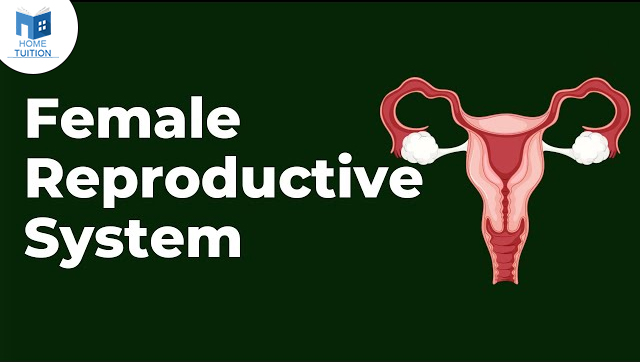The female reproductive system comprises both primary and accessory sex organs. The primary organs are the ovaries, which produce eggs and secrete female sex hormones like progesterone and estrogen. Accessory organs include the uterus, fallopian tubes, cervix, and vagina. External genitalia include the labia minora, labia majora, and clitoris. Mammary glands, though not genital organs, are crucial glands in the female reproductive system.
Female Reproductive System Diagram

Female Reproductive System Anatomy
The female reproductive system serves various functions. It produces egg cells, or ova, essential for reproduction. These ova are transported to the site of fertilization. Fertilization occurs in the Fallopian tubes, where the egg meets sperm. The fertilized egg then implants in the uterine wall, initiating pregnancy. Additionally, the female reproductive system produces female sex hormones to regulate the reproductive cycle.
Comprising a pair of ovaries, oviducts, vagina, cervix, uterus, and external genitalia in the pelvic region, the female reproductive system also includes mammary glands. These parts function together to support ovulation, fertilization, childbirth, and childcare.
Also Read: Human Reproductive System
Ovaries
These are oval shaped lying near the kidney.
- Ovary is covered by two layers outer is made up of germinal epithelial cells.
- Inner layer is called as tunica albuginea which is made up of fibrous connective tissues.
- The ovary consists of inner part called as stroma.
- It’s outer peripheral pat is called as cortex while inner part is called a medulla.
- Medulla consists of connective tissues containing numerous blood vessels, lymphatic vessels and nerves.
- Cortex consists of graffian follicles in all the stages of development.
Uterus
The uterus, also known as the womb, is a muscular, inverted pear-shaped organ within the female reproductive system. Its walls comprise three layers: the inner glandular layer, the middle thick layer, and the outer thin layer. These layers are supported by ligaments attached to the pelvic wall, opening into the vagina through a narrow cervix. The cervical canal, along with the vagina, forms the birth canal. The vagina, a muscular tube, extends from the lower end of the uterus to the exterior.
Fallopian Tubes
The Fallopian tubes are paired muscular and funnel-shaped structures. They extend from the upper corners of the uterus, on the right and left sides, to the edges of the ovaries. These tubes are surrounded by small projections called fimbriae, which sweep over the ovaries to collect released ova and transport them to the infundibulum for eventual delivery to the uterus. Cilia cover each Fallopian tube and assist in moving the ovum towards the uterus.
Also Read: Male Reproductive System
Vagina
The vagina, a muscular and elastic tube, connects the cervix to the external body. It serves as the receptacle for the penis during sexual intercourse and transports sperm to the fallopian tubes and uterus. Additionally, it acts as a birth canal, expanding to allow the delivery of the fetus during childbirth.
The external genitalia includes the labia minora, labia majora, and clitoris.
Ovulation
Ovulation is the process of releasing eggs from the ovaries. This occurs when the follicle is fully grown and reaches its size, with the accumulation of liquid in the follicle without a significant rise in pressure. The follicle swells, forming a clear cone area called the stigma or macula pellucida, which later undergoes changes in color, integrity, and translucency. The secretion of estrogen hormones reaches its peak before ovulation. After a surge of luteinizing hormone, ovulation occurs at the stigma, where the follicle separates, releasing the ovum surrounded by the corona radiata. The corona radiata cells separate in the presence of spermatozoa. In ruminants, the oocytes lose their corona at ovulation. The fimbriae at the end of the oviduct pick up the ovum. If fertilization does not occur, the ovum degenerates within 24 hours.
Also Read: Neurons
Menstrual Cycle
The menstrual cycle is a monthly process in which a mature egg cell is produced. An ovary releases a mature egg that travels to the uterus. If the egg is not fertilized, the uterine lining sheds, and a new cycle begins. The menstrual cycle, typically lasting 28 days, may vary from 21 to 35 days. Hormones such as FSH, LH, estrogen, and progesterone control the menstrual cycle. FSH and LH are produced by the pituitary gland, while estrogen and progesterone are produced by the ovaries. Factors like diet, exercise, stress, and weight changes can affect the menstrual cycle. Menstrual cycles occur monthly from puberty until around 45 to 55 years old, except during pregnancy. Hormone production decreases after 55, leading to the cessation of menstrual cycles and the inability to become pregnant.
Fertilization
- It included release of ovum from the ovary, where it remains viable for 12 - 24 hours.
- At the time of sexual intercourse the sperm enters in to the vagina.
- Only one sperm is required for fertilization of the ovum.
- The head of the sperm penetrates the corona radiate layer of ovum and then the zona pellucida layer.
- This process if facilitated by acrosome and proteolytic enzymes.
- After penetration the tail and body of the sperm is lost, only head remains inside the ovum.
- It’s head begins to swell and forms male pronucleus.
- Here the pronuclei of sperm and ovum fuse to from a new resultant nucleus each contributing 23 chromosome, so that the resultant may have 46 chromosomes.
Frequently Asked Questions
Ans. Its functions encompass the production of eggs, secretion of sex hormones (like estrogen), facilitation of fertilization, gestation of a fetus upon fertilization, birthing a baby, and breastfeeding post-birth. The only absence is sperm.
Ans. The 4 female reproductive organs are- vagina, uterus, fallopian tubes, and ovaries.
Ans. They are also known as sex cells. Female gametes are termed ova or egg cells, while male gametes are termed sperm.
Ans. During coitus, human sperm are ejaculated into the anterior vagina. To evade vaginal acid and immune responses, they promptly encounter cervical mucus and penetrate the cervix.